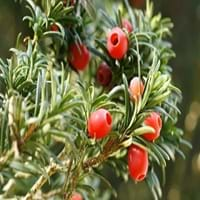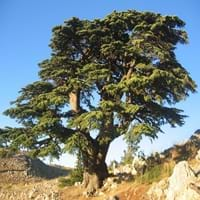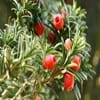Life Span
Perennial
Perennial
Type
Needled or Scaled Evergreen
Needled or Scaled Evergreen
Origin
Eastern Asia
Mediterranean, Turkey, Western Asia
Types
Not Available
Lebanon cedar, Turkish cedar
Number of Varieties
Not Available
Habitat
Dappled Shade, Shady Edge, Woodland Garden Secondary, Woodlands
Mountains
USDA Hardiness Zone
4-7
5-9
Sunset Zone
A2, A3, 2a, 2b, 3a, 3b, 4, 5, 14, 15, 16, 17
3a, 3b, 4, 5, 6, 7, 8, 9, 10, 14, 15, 16, 17, 18, 19, 20, 21, 22, 23, 24
Habit
Upright/Erect
Spreading
Flower Color
Non Flowering Plant
Light Green
Flower Color Modifier
Bicolor
Bicolor
Fruit Color
Red
Light brown, Light Green, Lime Green, Sandy Brown
Leaf Color in Spring
Dark Green
Light Green, Gray Green, Dark Green
Leaf Color in Summer
Dark Green
Gray Green, Dark Green
Leaf Color in Fall
Dark Green
Gray Green, Dark Green
Leaf Color in Winter
Dark Green, Bronze
Gray Green, Dark Green
Leaf Shape
Pinnate
Needle like
Plant Season
Spring, Summer, Fall, Winter
Spring, Summer, Fall, Winter
Sunlight
Full Sun, Partial Sun, Partial shade, Full Shade
Full Sun, Partial Sun
Type of Soil
Loam
Clay, Loam, Sand
The pH of Soil
Acidic, Neutral, Alkaline
Acidic, Neutral, Alkaline
Soil Drainage
Well drained
Well drained
Bloom Time
Fall, Spring, Summer, Winter
Mid fall
Tolerances
Drought
Drought
Where to Plant?
Ground
Ground
How to Plant?
Stem Cutting, stem tip cuttings, Tip cutting
Seedlings, Semi-hardwood cuttings
Plant Maintenance
Medium
Medium
Watering Requirements
Average Water Needs, Do Not over Water, Do not water frequently
Never Over-water, Requires regular watering
In Summer
Lots of watering
Lots of watering
In Spring
Moderate
Moderate
In Winter
Average Water
Average Water
Soil pH
Acidic, Neutral, Alkaline
Acidic, Neutral, Alkaline
Soil Type
Loam
Clay, Loam, Sand
Soil Drainage Capacity
Well drained
Well drained
Sun Exposure
Full Sun, Partial Sun, Partial shade, Full Shade
Full Sun, Partial Sun
Pruning
Remove damaged leaves, Remove dead branches, Remove dead leaves
Remove damaged leaves, Remove dead branches, Remove dead leaves
Fertilizers
All-Purpose Liquid Fertilizer
All-Purpose Liquid Fertilizer
Pests and Diseases
Red blotch
Honey fungus, Root rot
Plant Tolerance
Drought
Drought
Flower Petal Number
Single
Single
Fragrant Bark/Stem
No
Yes
Foliage Texture
Fine
Fine
Foliage Sheen
Not Available
Not Available
Attracts
Aphids, Mealybugs, White Pine Weevil
Aphids
Allergy
Pollen
Asthma, Runny nose, Skin irritation
Aesthetic Uses
Bonsai, Borders
Landscape Designing
Beauty Benefits
Not Available
Not Available
Environmental Uses
Air purification
Air purification
Medicinal Uses
anti-cancer
Antiseptic, Expectorant, Respiratory Disorders
Part of Plant Used
Fruits, Wood
Branch, Leaves, Wood
Other Uses
Used as a dye, Wood is used for making furniture
Oil is used in perfume, soaps, creams, etc., Used as essential oil, Used for fragrance, Used for its medicinal properties, Used in construction
Used As Indoor Plant
No
No
Used As Outdoor Plant
Yes
Yes
Garden Design
Feature Plant, Foundation, Groundcover, Hedges, Screening, Wind Break, Topiary, Bonsai, Espalier
Feature Plant, Shade Trees
Botanical Name
TAXUS cuspidata
CEDRUS libani
Common Name
spreading yew
Lebanon cedar, cedar of Lebanon
In Hindi
Japanese Yew
लेबनान देवदार
In German
japanische Eibe
Libanon-Zeder
In French
Japanese Yew
Cèdre du Liban
In Spanish
tejo japonés
Cedrus libani
In Greek
Ιαπωνικά Yew
Λίβανος κέδρου
In Portuguese
Xapanese Filho
Cedro-do-líbano
In Polish
Xapanese Son
Cedr libański
In Latin
Filius Xapanese
Cedrus libani
Phylum
Tracheophyta
Coniferophyta
Class
Pinopsida
Pinopsida
Clade
Not Available
Not Available
Tribe
Not Available
Not Available
Subfamily
Not Available
Not Available
Number of Species
Not Available
Season and Care of Japanese Yew and Cedar of Lebanon
Season and care of Japanese Yew and Cedar of Lebanon is important to know. While considering everything about Japanese Yew and Cedar of Lebanon Care, growing season is an essential factor. Japanese Yew season is Spring, Summer, Fall and Winter and Cedar of Lebanon season is Spring, Summer, Fall and Winter. The type of soil for Japanese Yew is Loam and for Cedar of Lebanon is Clay, Loam, Sand while the PH of soil for Japanese Yew is Acidic, Neutral, Alkaline and for Cedar of Lebanon is Acidic, Neutral, Alkaline.
Japanese Yew and Cedar of Lebanon Physical Information
Japanese Yew and Cedar of Lebanon physical information is very important for comparison. Japanese Yew height is 90.00 cm and width 150.00 cm whereas Cedar of Lebanon height is 2,440.00 cm and width 1,520.00 cm. The color specification of Japanese Yew and Cedar of Lebanon are as follows:
Japanese Yew flower color: Non Flowering Plant
Japanese Yew leaf color: Dark Green
Cedar of Lebanon flower color: Light Green
- Cedar of Lebanon leaf color: Light Green, Gray Green and Dark Green
Care of Japanese Yew and Cedar of Lebanon
Care of Japanese Yew and Cedar of Lebanon include pruning, fertilizers, watering etc. Japanese Yew pruning is done Remove damaged leaves, Remove dead branches and Remove dead leaves and Cedar of Lebanon pruning is done Remove damaged leaves, Remove dead branches and Remove dead leaves. In summer Japanese Yew needs Lots of watering and in winter, it needs Average Water. Whereas, in summer Cedar of Lebanon needs Lots of watering and in winter, it needs Average Water.





